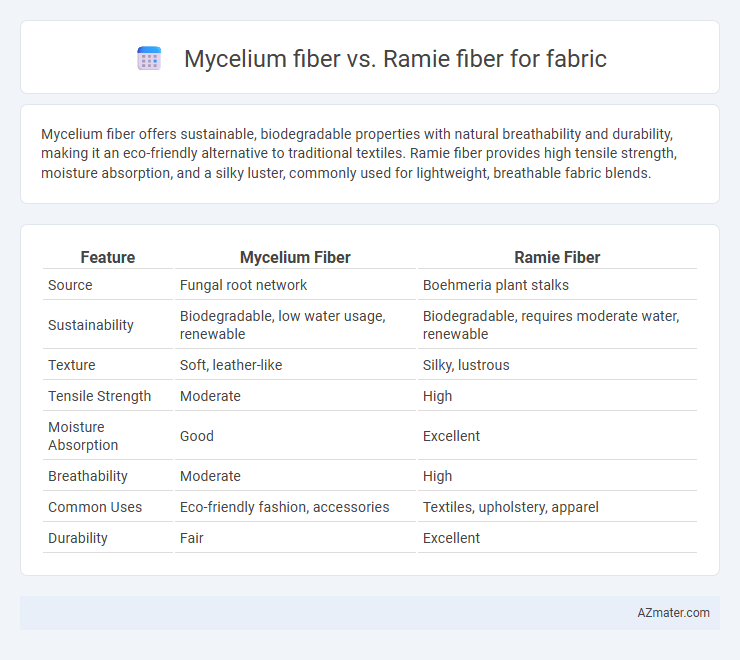Mycelium fiber offers sustainable, biodegradable properties with natural breathability and durability, making it an eco-friendly alternative to traditional textiles. Ramie fiber provides high tensile strength, moisture absorption, and a silky luster, commonly used for lightweight, breathable fabric blends.
Table of Comparison
| Feature | Mycelium Fiber | Ramie Fiber |
|---|---|---|
| Source | Fungal root network | Boehmeria plant stalks |
| Sustainability | Biodegradable, low water usage, renewable | Biodegradable, requires moderate water, renewable |
| Texture | Soft, leather-like | Silky, lustrous |
| Tensile Strength | Moderate | High |
| Moisture Absorption | Good | Excellent |
| Breathability | Moderate | High |
| Common Uses | Eco-friendly fashion, accessories | Textiles, upholstery, apparel |
| Durability | Fair | Excellent |
Introduction to Mycelium Fiber and Ramie Fiber
Mycelium fiber, derived from the root structure of fungi, offers a sustainable and biodegradable alternative for fabric production with natural antimicrobial properties and high breathability. Ramie fiber, extracted from the stalks of the Boehmeria plant, is known for its strength, lustrous appearance, and resistance to wrinkling, making it a durable choice for textiles. Both fibers represent eco-friendly options, with Mycelium emphasizing biodegradability and innovation, while Ramie highlights traditional strength and silky texture in fabric applications.
Origin and Production Processes
Mycelium fiber originates from fungal mycelium, which is cultivated by growing fungal networks on organic substrates under controlled conditions, then processed into sustainable, biodegradable fabric. Ramie fiber is derived from the stalks of the Ramie plant (Boehmeria nivea), harvested, dried, and mechanically degummed to extract stiff, lustrous natural fibers commonly used in textiles. While Mycelium fiber production emphasizes fungal biotechnology and rapid growth cycles, Ramie fiber relies on traditional agricultural cultivation and labor-intensive retting and degumming processes.
Sustainability and Environmental Impact
Mycelium fiber offers a sustainable alternative to traditional fibers by utilizing fungal mycelium, which grows rapidly with minimal water, no pesticides, and low energy inputs, reducing environmental footprint significantly compared to Ramie fiber. Ramie fiber, derived from the stalks of the Boehmeria plant, is biodegradable and has high tensile strength but requires extensive chemical processing and substantial water use, impacting eco-friendliness. Mycelium fiber's biodegradability and ability to sequester carbon make it a more environmentally sustainable choice for fabric production in comparison to Ramie.
Physical Properties and Texture
Mycelium fiber exhibits lightweight, flexible, and porous physical properties, making it highly breathable and soft with a texture reminiscent of suede, ideal for sustainable fashion applications. Ramie fiber is known for its strength, smoothness, and high absorbency, with a lustrous silk-like texture that gives fabrics a crisp, stiff feel suitable for durable textiles. Both fibers offer distinct tactile experiences, where mycelium excels in softness and flexibility, while ramie provides robustness and a glossy finish.
Durability and Longevity
Mycelium fiber offers remarkable durability due to its dense, interwoven hyphal structure, making it highly resistant to wear and tear compared to traditional fibers. Ramie fiber is known for its strength and resistance to stretching and shrinking, though it may degrade faster under prolonged exposure to sunlight and moisture. In terms of longevity, mycelium fiber's natural resistance to microbial attack and environmental factors gives it an edge over ramie fiber, which requires careful maintenance to preserve its integrity over time.
Breathability and Comfort in Clothing
Mycelium fiber offers excellent breathability due to its porous structure, allowing efficient air circulation and moisture wicking, which enhances comfort in clothing. Ramie fiber is naturally absorbent and breathable, providing a lightweight and soft texture that promotes a cooling effect in warm conditions. Both fibers contribute to comfort, but Mycelium's unique cellular composition gives it a slight advantage in moisture management and thermal regulation.
Dyeing, Finishing, and Aesthetic Appeal
Mycelium fiber offers unique dyeing properties as its porous structure allows for vibrant color absorption and eco-friendly natural dyes, resulting in rich, earthy tones. Ramie fiber, known for its smooth, lustrous surface, provides excellent dye retention and a glossy finish that enhances fabric brightness and sharpness. In terms of aesthetic appeal, Mycelium fabric exhibits a textured, organic look ideal for artisanal designs, while Ramie's silky sheen delivers a polished, luxurious appearance favored in high-end textiles.
Applications in Fashion and Textiles
Mycelium fiber offers sustainable and biodegradable properties, making it ideal for eco-friendly fashion collections, while Ramie fiber, known for its strength and lustrous texture, is favored for high-quality upholstery and garments requiring durability. Both fibers provide breathable and lightweight fabrics, with Mycelium excelling in innovative, avant-garde textile designs and Ramie commonly used in traditional and luxury apparel. The integration of Mycelium in fashion promotes circular economy principles, whereas Ramie's natural resistance to bacteria enhances longevity and comfort in textile applications.
Cost and Market Availability
Mycelium fiber offers a sustainable alternative with emerging production technologies, but its cost remains higher than traditional fibers like ramie due to limited scale and specialized processing requirements. Ramie fiber, derived from the ramie plant, is widely available in markets with established supply chains, making it more cost-effective and accessible for fabric manufacturing. Market demand favors ramie for its affordability and natural luster, while mycelium fiber's niche applications appeal to eco-conscious brands despite premium pricing.
Future Trends and Innovation in Fiber Technology
Mycelium fiber offers a sustainable alternative to traditional Ramie fiber, leveraging bioengineered fungal networks to create biodegradable, lightweight fabrics with enhanced moisture-wicking properties. Innovations in mycelium processing enable customization at the molecular level, surpassing Ramie's durability and tensile strength for high-performance textiles. Future trends emphasize integrating mycelium fibers into smart fabrics and circular economies, positioning them as a revolutionary material in eco-friendly and functional textile manufacturing.

Infographic: Mycelium fiber vs Ramie fiber for Fabric
 azmater.com
azmater.com